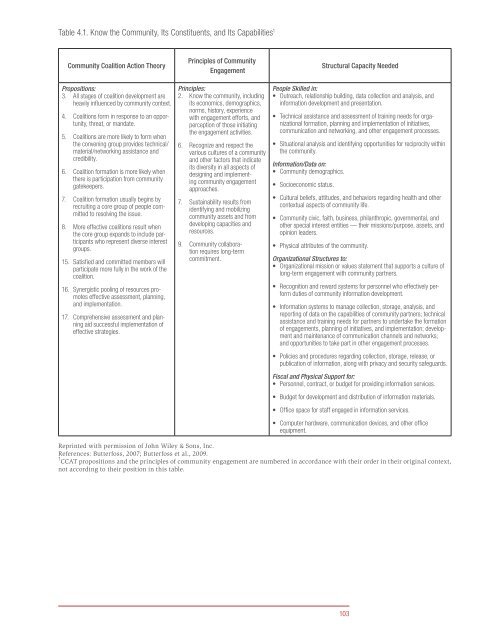Principles of Community Engagement (Second Edition)
Principles of Community Engagement (Second Edition)
Principles of Community Engagement (Second Edition)
You also want an ePaper? Increase the reach of your titles
YUMPU automatically turns print PDFs into web optimized ePapers that Google loves.
Table 4.1. Know the <strong>Community</strong>, Its Constituents, and Its Capabilities 1<br />
<strong>Community</strong> Coalition Action Theory<br />
Propositions:<br />
3. All stages <strong>of</strong> coalition development are<br />
heavily influenced by community context.<br />
4. Coalitions form in response to an opportunity,<br />
threat, or mandate.<br />
5. Coalitions are more likely to form when<br />
the convening group provides technical/<br />
material/networking assistance and<br />
credibility.<br />
6. Coalition formation is more likely when<br />
there is participation from community<br />
gatekeepers.<br />
7. Coalition formation usually begins by<br />
recruiting a core group <strong>of</strong> people committed<br />
to resolving the issue.<br />
8. More effective coalitions result when<br />
the core group expands to include participants<br />
who represent diverse interest<br />
groups.<br />
15. Satisfied and committed members will<br />
participate more fully in the work <strong>of</strong> the<br />
coalition.<br />
16. Synergistic pooling <strong>of</strong> resources promotes<br />
effective assessment, planning,<br />
and implementation.<br />
17. Comprehensive assessment and planning<br />
aid successful implementation <strong>of</strong><br />
effective strategies.<br />
<strong>Principles</strong> <strong>of</strong> <strong>Community</strong><br />
<strong>Engagement</strong><br />
<strong>Principles</strong>:<br />
2. Know the community, including<br />
its economics, demographics,<br />
norms, history, experience<br />
with engagement efforts, and<br />
perception <strong>of</strong> those initiating<br />
the engagement activities.<br />
6. Recognize and respect the<br />
various cultures <strong>of</strong> a community<br />
and other factors that indicate<br />
its diversity in all aspects <strong>of</strong><br />
designing and implementing<br />
community engagement<br />
approaches.<br />
7. Sustainability results from<br />
identifying and mobilizing<br />
community assets and from<br />
developing capacities and<br />
resources.<br />
9. <strong>Community</strong> collaboration<br />
requires long-term<br />
commitment.<br />
Structural Capacity Needed<br />
People Skilled in:<br />
• Outreach, relationship building, data collection and analysis, and<br />
information development and presentation.<br />
• Technical assistance and assessment <strong>of</strong> training needs for organizational<br />
formation, planning and implementation <strong>of</strong> initiatives,<br />
communication and networking, and other engagement processes.<br />
• Situational analysis and identifying opportunities for reciprocity within<br />
the community.<br />
Information/Data on:<br />
• <strong>Community</strong> demographics.<br />
• Socioeconomic status.<br />
• Cultural beliefs, attitudes, and behaviors regarding health and other<br />
contextual aspects <strong>of</strong> community life.<br />
• <strong>Community</strong> civic, faith, business, philanthropic, governmental, and<br />
other special interest entities — their missions/purpose, assets, and<br />
opinion leaders.<br />
• Physical attributes <strong>of</strong> the community.<br />
Organizational Structures to:<br />
• Organizational mission or values statement that supports a culture <strong>of</strong><br />
long-term engagement with community partners.<br />
• Recognition and reward systems for personnel who effectively perform<br />
duties <strong>of</strong> community information development.<br />
• Information systems to manage collection, storage, analysis, and<br />
reporting <strong>of</strong> data on the capabilities <strong>of</strong> community partners; technical<br />
assistance and training needs for partners to undertake the formation<br />
<strong>of</strong> engagements, planning <strong>of</strong> initiatives, and implementation; development<br />
and maintenance <strong>of</strong> communication channels and networks;<br />
and opportunities to take part in other engagement processes.<br />
• Policies and procedures regarding collection, storage, release, or<br />
publication <strong>of</strong> information, along with privacy and security safeguards.<br />
Fiscal and Physical Support for:<br />
• Personnel, contract, or budget for providing information services.<br />
• Budget for development and distribution <strong>of</strong> information materials.<br />
• Office space for staff engaged in information services.<br />
• Computer hardware, communication devices, and other <strong>of</strong>fice<br />
equipment.<br />
Reprinted with permission <strong>of</strong> John Wiley & Sons, Inc.<br />
References: Butterfoss, 2007; Butterfoss et al., 2009.<br />
1<br />
CCAT propositions and the principles <strong>of</strong> community engagement are numbered in accordance with their order in their original context,<br />
not according to their position in this table.<br />
103

















